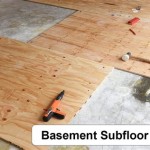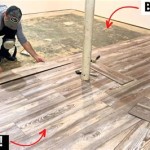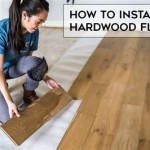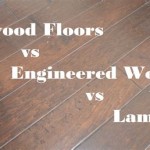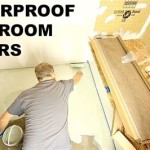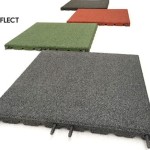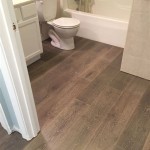Is Carpet Tape Bad For Hardwood Floors And Walls?
Carpet tape is a widely used adhesive product designed primarily to secure carpets, rugs, and other floor coverings to various surfaces. Its convenience and ease of application make it a popular choice for both temporary and semi-permanent installations. However, the question of whether carpet tape is detrimental to hardwood floors and walls is a significant concern for homeowners and renters alike. Understanding the potential risks and benefits associated with its use is crucial for making informed decisions about floor covering installation and removal.
The composition of carpet tape varies depending on the manufacturer and intended application. Generally, it consists of a carrier material, such as fabric, paper, or plastic film, coated on both sides with an adhesive. The adhesive can be made from a variety of materials, including rubber-based compounds, acrylic polymers, or other synthetic resins. Some tapes are designed for light-duty applications, while others are formulated for heavy-duty use and are capable of creating a much stronger bond. The strength and type of adhesive are key factors that determine the potential for damage to underlying surfaces.
When applied to hardwood floors, carpet tape can interact with the finish and the wood itself, potentially leading to various problems. Similarly, its use on walls, especially painted surfaces, can result in paint peeling, residue buildup, and even damage to the underlying drywall or plaster. The extent of the damage depends not only on the type of tape used but also on the condition and composition of the surface to which it is applied, the duration of the application, and the method used for removal.
Potential Damage to Hardwood Floors
Hardwood floors are prized for their beauty, durability, and timeless appeal. Maintaining their pristine condition is a priority for many homeowners. However, the application of carpet tape can pose several risks to the integrity of hardwood floors. One of the primary concerns is the potential for adhesive residue to remain on the floor after the tape is removed. This residue can be difficult to clean, and it may attract dirt and grime, leading to a dull or sticky surface. The type of adhesive used in the tape significantly impacts the severity of the residue problem.
Furthermore, some carpet tapes can damage the finish of hardwood floors. The adhesive can react with the polyurethane or other protective coatings, causing discoloration, clouding, or even peeling. This is particularly problematic with older floors that may have a more delicate or aging finish. The solvents present in certain adhesives can also soften or dissolve the finish, making it more susceptible to scratching and wear. The level of damage depends on the chemical compatibility between the adhesive and the floor finish, as well as the duration of contact.
In more severe cases, carpet tape can even damage the wood itself. If a strong adhesive is used and left in place for an extended period, it can penetrate the pores of the wood, creating a permanent bond. When the tape is eventually removed, it can pull away splinters or fragments of the wood surface, leaving behind noticeable imperfections. This type of damage is more likely to occur with softer woods or floors that have pre-existing cracks or imperfections. Refinishing the floor may be necessary to repair the damage, which can be a costly and time-consuming process.
The age and condition of the hardwood floor also play a crucial role in determining the potential for damage. Older floors, which may have multiple layers of finish or a weakened structure, are generally more susceptible to damage from carpet tape than newer, well-maintained floors. Similarly, floors that have been previously refinished or treated with certain cleaning products may react differently to the adhesive. Careful consideration of the floor's history and composition is essential before using carpet tape.
Risks Posed to Walls and Painted Surfaces
Similar to hardwood floors, walls and painted surfaces are also vulnerable to damage from carpet tape. The most common problem associated with using carpet tape on walls is paint peeling. The adhesive can create a strong bond with the paint, and when the tape is removed, it can pull away the paint layer, leaving behind unsightly bare spots or uneven textures. This is particularly problematic with latex-based paints, which tend to be more flexible and less resistant to tearing than other types of paint. The quality and adhesion of the paint also influence the likelihood of peeling.
Even if the paint doesn't peel immediately, carpet tape can leave behind a sticky residue that is difficult to remove. This residue can attract dust, dirt, and other particles, creating a dirty and unsightly area on the wall. Attempting to clean the residue with harsh chemicals or abrasive cleaners can further damage the paint, leading to discoloration or a loss of sheen. Gentle cleaning methods, such as using a mild soap and water solution, are often recommended, but they may not always be effective in removing stubborn adhesive residue.
In some cases, carpet tape can also damage the underlying wall material, such as drywall or plaster. If the tape is applied to a wall that has pre-existing cracks or imperfections, it can exacerbate these problems during removal. The adhesive can seep into the cracks, creating a stronger bond and making it more difficult to remove the tape without causing further damage. In severe cases, the drywall or plaster may crumble or break apart, requiring repairs before the wall can be repainted. The age and condition of the wall are important factors to consider when deciding whether to use carpet tape.
The type of paint used on the wall also influences the potential for damage. Glossy or semi-gloss paints tend to be more resistant to peeling than matte or flat paints, as they have a smoother surface and better adhesion. However, even glossy paints can be damaged by carpet tape if the adhesive is too strong or if the tape is left in place for an extended period. Thoroughly cleaning the wall before applying the tape can help to improve adhesion and reduce the risk of damage, but it's not a foolproof solution.
Alternatives to Carpet Tape and Mitigation Strategies
Given the potential risks associated with using carpet tape on hardwood floors and walls, exploring alternative methods for securing carpets and rugs is often advisable. Several options offer similar functionality with a reduced risk of damage. For hardwood floors, consider using rug pads with a non-slip backing. These pads provide cushioning and prevent the rug from sliding without relying on adhesives. They are available in various sizes and materials to suit different types of rugs and floors.
Another alternative is to use area rugs with built-in non-slip backings. These rugs are designed to stay in place without the need for additional adhesives or pads. They are a convenient option for high-traffic areas or homes with children and pets. However, it's important to choose rugs with high-quality backings that won't damage the floor finish.
For securing items to walls, consider using removable adhesive hooks or strips that are specifically designed for painted surfaces. These products are formulated to provide a strong hold without damaging the paint upon removal. They are available in various sizes and weight capacities to accommodate different types of items. It's important to follow the manufacturer's instructions carefully to ensure proper installation and removal.
If carpet tape is unavoidable, minimize the risk of damage by taking certain precautions. First, choose a low-tack tape specifically designed for delicate surfaces. These tapes have a weaker adhesive that is less likely to damage the floor or wall. Test the tape on an inconspicuous area before applying it to the entire surface. This will help to determine whether the tape is compatible with the finish and whether it will leave behind any residue.
Limit the duration of tape application. The longer the tape is left in place, the greater the risk of damage. Remove the tape as soon as it is no longer needed. When removing the tape, pull it slowly and carefully at a 45-degree angle. This will help to minimize the stress on the surface and reduce the likelihood of peeling or tearing. If any adhesive residue remains, use a mild solvent, such as mineral spirits or adhesive remover, to gently dissolve it. Always test the solvent on an inconspicuous area first to ensure that it doesn't damage the finish.
Finally, consider consulting with a professional flooring or painting contractor before using carpet tape on delicate surfaces. They can provide expert advice on the best methods for securing carpets and rugs without damaging your floors or walls. They can also help to repair any existing damage caused by carpet tape and recommend appropriate cleaning and maintenance products.

Pros And Cons Of Applying Rug Tape On Your Floors Carpets Rugpadusa

Pros And Cons Of Applying Rug Tape On Your Floors Carpets Rugpadusa

Pros And Cons Of Applying Rug Tape On Your Floors Carpets Rugpadusa

Flooring How Can I Remove Carpet Adhesive From Hardwood Floors Home Improvement Stack Exchange

Roberts Rug Gripper 60 Ft Indoor Carpet Tile Solid Hardwood Laminate Vinyl Tape Roll 50 588 The Home

Flipkart Com Rexmon Double Sided Carpet Tape Heavy Duty Super Strong Sticky For Non Slip Waterproof Removable Mesh Grid Suitable Hardwood Floors Mats Wall Cellotapes Manual

Homeeasy 1 875 In X 75 Ft Tan Double Sided Seam Tape 142435 At Com

How To Remove Carpet Photos Young House Love

L And Stick Flooring 5 Myths Debunked

Rug Tape Grip Neutral Mohawk Home Carpet For Area Rugs Hardwood Floors Adhesive Off White 15ft X 2 5in
See Also
